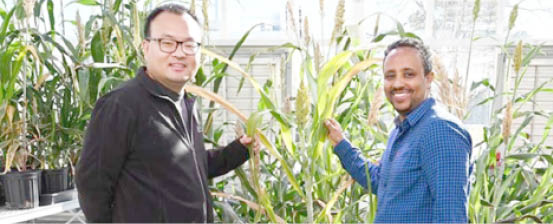Scientists at the U.S. Department of Energy (DOE) Brookhaven National Laboratory and the Oklahoma State University have identified key genes that control flowering in sorghum. Sorghum, an important bioenergy crop, has a limited growth period in which biomass can be accumulated before the plant transitions into the reproductive flowering phase. The findings, published in the journal New Phytologist, explain strategies to delay sorghum flowering, which would allow maximized plant growth and biomass availability for bioproduct and biofuel production.
“Our studies elucidate the gene regulatory network controlling sorghum flowering and provide new insights into how these genes could be leveraged to improve sorghum for achieving bioenergy goals,” said Brookhaven Lab biologist Meng Xie, according to a press release.
Sorghum is well suited for sustainable agriculture due to its ability to grow on marginal lands, and its tolerance of semi-arid regions and relatively high temperatures. The growth and flowering (reproductive) cycles of sorghum are regulated by the duration of sunlight. When a plant begins to flower, it stops growing. An understanding of genes that change and control flowering time could help optimize sorghum grown for both food and biofuel uses.
Depending on the variety of sorghum, the plant may flower earlier or later, effecting biomass accumulation. For example, one sorghum variety waits until fall to flower, allowing it to reach nearly 20 feet in height. Other varieties flower earlier in the growing season, so only grow to about three feet in height. While this means earlier flower varieties produce grain more efficiently, it also means they produce significantly less vegetation.
- Earnings from vegetables decline despite high cost of inputs – Farmers
- Plant early if you can, Emir of Muri tells farmers
“While these earlier flowering varieties might be preferable when growing sorghum as a food source, for bioenergy production, we prefer sorghum to have later flowering. That gives the plants more time to grow and accumulate biomass in the stems and leaves,” said Xie.
Brookhaven’s team began by exploring a gene called SbGhd7, which was previously associated with later flowering. Evidence of the gene’s correlation to a reduced or non-existent flowering cycle was revealed when transgenic sorghum plants were engineered at Oklahoma State to overexpress the flowering-control gene. Sorghum varieties with this gene overexpression did not flower at all and had more than twice the biomass of control plants.
To find out why, Xie’s team unraveled how the protein (coded by the gene that repressed flowering) interacted with other genes.
Conducting studies in full grown plants would have taken months, if not years, to complete. Instead, Xie and his colleagues at Brookhaven used individual plant cells without outer cell walls. The cells, known as protoplasts, easily absorbed plasmid (small sections of DNA) when it was added to the growth medium. By turning the wanted genes into plasmid, the plant cells could make the desired protein. To track the activity of the protein in the cells, the scientists attached a small protein as a tracker. They also added antibodies to flag where the wanted gene bound to the plant’s original, genomic DNA so they could remove the antibody-protein-DNA complex to sequence the gene regions.
“This method, called ‘transient chromatin immunoprecipitation-sequencing’ or ‘Transient ChIP-seq’ showed us where the protein that eliminates flowering binds to on sorghum genomic DNA. It identifies the targets of this regulator protein in the sorghum genome,” said Xie.
Collaborators at Oklahoma State tested sorghum plants that overexpressed the genes that were understood to be related to flowering. When the Brookhaven scientists tested their flower repressor protein, they found that it was binding to many of the targeted flowering genes. With this understanding, Xie’s team identified the regulator protein’s specific binding site: a very short DNA sequence within the “on” switch, or promoter, for each individual target gene.
“The promoter of each target gene is different, but they all contain this same short sequence,” Xie said, according to the press release, “Others had speculated that the original regulator protein only regulated one flowering activator. But we found it is much more complicated. In addition to regulating one suspected target activator, this protein also regulates several others — some directly and some indirectly. It’s like a master regulator for turning off flowering.”
Growing sorghum that doesn’t flower, aside from increased biomass, would also carry a built-in gene containment system: as the plant would never flower, there would be no opportunity to share altered genes with close plants. This could help growers meet regulations in real-world agricultural environments.
SOURCE: SeedWorld

 Join Daily Trust WhatsApp Community For Quick Access To News and Happenings Around You.
Join Daily Trust WhatsApp Community For Quick Access To News and Happenings Around You.


